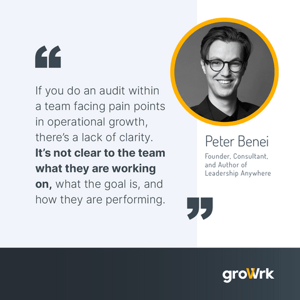How to scale your operations in a rapidly growing global business
 Mara Quintanilla
Mara Quintanilla
We are living in times of large-scale changes in the world of work. More companies every year are becoming remote and don’t even get us started on automation or the buzzword of 2023, AI. While top employees overwhelmingly prefer flexible work, the truth is, most people don’t think about the network of innovators that make all these advancements and commodities in our lives possible.
That is why we created the “Let’s Talk Tech Series.” We wanted to fill the gap of content for remote workers and IT leaders and help prepare the people on the front lines of these changes.
Every month we will offer advice, opinions, and breaking news through interviews with the industry’s leading professionals.
We hope you enjoy this week’s issue!
This week’s guest: Peter Benei
Peter Benei is a mentor, a fractional leader, and a speaker. He began his career by working in marketing in his native city of Budapest and then quickly found leadership roles in the UK and the U.S. Over the course of 8 years, he worked his way up to the Chief Marketing Officer position for several startups and was introduced to managing remote teams. Peter found incredible success managing his teams through this period but saw how so many other companies struggled once the pandemic began.
This inspired him to write a book on how to become an asynchronous leader and start the Anywhere Consulting Business. He now advises and coaches remote leaders to be able to create a culture that fosters productivity and work-life balance. He also started the Leadership Anywhere podcast to get other remote leaders to share their experiences weekly.
We spoke with him to understand how, in his consulting experience, he has been able to help managers scale their operations remotely.
Key indicators of outgrown business capacity

Working with founders and leaders of scale-ups –that is, start-ups with a headcount of around 50 to 100 people– Peter has found several main indicators when a business has outgrown its business capacity.
They are a lack of clarity, orientation, and transparency. This then leads to struggles with operational growth when teams lag on projects, miss deadlines, and have a high churn.
A lack of clarity means people do not know what they are working on. “If you do an audit within the team, it’s not really clear to them what the goal is and how they are performing. They are very busy in terms of developing the product or service they offer and marketing it to the public. We usually think it's an easy-flowing machine because we see enterprises and big companies doing that. But for a small team, or a small company, or a new company, it's a hardship,” he explains.
“They are not really invested, not because they don't want to, but because they don't have the time and the resources to invest in finding out how to tackle these problems. That's when you must deal with these issues.”
In these situations, when a company's growth is driven by investors or a certain revenue target, there is pressure to grow rapidly, sometimes doubling headcount within just a few months. However, this fast-paced growth can lead to inefficiencies and mistakes. According to Peter, these problems occur when there’s a low level of orientation for the team members, “People, plain and simple, don't know what is going on. The change is too fast.”
The fact that employees don’t know what to do has to do with a lack of transparency within the workplace. The main issue, Peter says, is, “The project is only living on the project management board, and it's really hard to get information about the project. It's not documented. It's distributed to people through meetings, talks, chats, and emails, which are not efficient ways of distributing knowledge within a team.”
For Peter, the challenges that startups face when scaling operations are connected to collaboration and communication. When there is a lack of communication and people are working in silos, this signals the business has outgrown its capacity and has to address it to continue experiencing rapid growth.
These problems can be avoided with documentation and a transparent management style, which makes it easy to put workers up to speed and shorten the time frame for onboarding. It delivers a clear message about the end goal of each person’s tasks, why they are working on them, and why employees are at the company.
Misconceptions about global growth
When asked about the strategies and best practices that leaders can use to scale up and experience global growth, Peter poses a defining difference between remote and non-remote businesses. He suggests there’s a problem for businesses that have experienced rapid growth while being location-independent.
“By developing really rapid growth, it's really hard to keep people aligned, keep people on the same ship, especially because they are remote,” Peter adds. “The keyword here is sustainable. Everyone can grow rapidly. If you are a scale-up, and you get 50 million dollars of funding, you can grow rapidly because there is cash in the bank, and you can spend that on growth, but that growth won't be sustainable. So you will burn that cash within one or two years and end up with a highly inflated team that doesn't know what to do. They are not producing 100% during the job, the projects are lacking, so the growth that you experienced as a high growth won’t become sustainable.”
Instead, he proposes the goal for scale-up founders should not be to establish rapid growth but to create sustainable growth lasting for five, ten, or more years. Additionally, public and transparent documentation is crucial.
Managers usually get scared at the idea of transparency, Peter says. However, Fortune 500 companies or those listed on the Stock Exchange are open and transparent with their figures. If it works for them, why wouldn’t it work for your startup?
Nowadays, there’s a practice among companies called open startup, Peter adds, where most of their operations are transparent, and anyone can see what they are doing and how. They share growth figures, how they compensate their people, how they work together, and what tools and resources they use. Even someone who doesn’t work for the company can read what they are doing.
This kind of transparent setup helps a company grow and scale because it’s easy to onboard new people. Everyone is familiar with what you are doing because everything is transparent.
Frameworks for achieving business growth

According to Peter, the best framework for growth is documentation. Companies usually think that when they lack operational growth, the answer is to hire more people, but that’s counterintuitive. If you have a marketing problem, he explains, you don’t need to hire a full-fledged team of 10 people; “you need one person and a really flawless clear and precise documented framework.”
“You need to have shared knowledge, a company hub, where you host all of your workflows, processes, templates, meeting notes, and everything that's connected to how you work and what you're working on. It has to be templatized because If it's a template, it is replicated easily, and it’s easy to understand by others. Once you have that collection of documentation, then the others who are joining the team later on, you can shorten onboarding times, saving time on productivity, and everyone will be super clear on what needs to be done within a week or two.”
“What happens normally is you hire someone, and you want them to ramp up within weeks. That's not going to happen. Usually, it takes three to six months to actually get someone who is a new hire to at least 80% because it takes time to understand what is going on. It takes time to gather all the intrinsic information. All the things that are in the CEO’s head, in the manager’s head, in everyone's head, and by documenting, what's in their heads, it's easier, it's quicker, and it's faster.”
“Imagine if you spend two years in a startup company, and it takes half a year or three to six months to understand what the heck is going on, the business lost almost 30% of productivity on the person who they hired. That's an insane loss. That's a waste of money.”
Tools needed in scaling operations
In Peter’s own words: “There is an abundance of tools and solutions on the Internet for remote teams, but what really matters is that the manager who is sourcing and setting up the tool understands why they are using it, how will they use it, and then invest time, energy, and resources to make sure that that tool serves the business.”
One of the main problems with classic management, he notes, is that leaders try to solve problems with tools. For organizations with thousands of people and massive operations, that can work because “you throw in a tool and based on the percentages, things improve because it's a massive thing. But if you have 15 to 100 people, it doesn't matter.”
Peter suggests that organizations keep things simple by using only five tools to manage company operations:
“You only need five tools: one tool for the company hub, for documentation; one tool for file management; one tool for meeting and discussion, for synchronous communication; one tool for chatting, like Slack; and one tool for operations, like administration and HR. Maybe a few variations for smaller tasks underneath these, but you only need five tools. Honestly, it doesn't really matter what tools you use. It's always based on the manager who is setting up the tool and framing to the team why they are using it.
When asked if he thinks businesses struggle due to inadequate technology during the growth phase, Peter says it’s a knowledge problem, not a resource problem. Since tools are abundant and teams can choose from a wide range of them, the problem lies in managers not understanding why and how they need to use those tools.
How to foster an organizational culture that embraces growth
In a remote setting, communication, and culture are vital for scalability. Leaders must be able to foster an organizational culture that embraces change and growth while still maintaining the company's core values.
For Peter, organizational culture is highly underestimated, as people fail to understand its importance in laying the foundation for growth. He suggests managers do four things to maintain this culture: listening to what employees have to say, giving autonomy and authority to anyone who has the expertise, creating activities that foster collaboration, and hosting an annual offline retreat.
Listening to employees
Peter explains that by listening to the people within your team, you can understand more about them. “That's the basic point because managers don't really want to listen. They usually speak a lot. They tend to monologue over an all-hands meeting,” he adds.
Granting autonomy and authority
When it comes to providing autonomy and authority, Peter says: “I don't care if someone is from Europe, Asia, or Africa. As long as they have the expertise for their job, they should be autonomous and have the authority to decide and work on their projects independently. They should be able to ask questions or seek feedback or support from their managers, and the managers should provide that feedback and support for anyone who's working on the project or any kind of work.”
Organizing intentional activities
One way to promote collaboration and inclusivity within a team is by organizing intentional activities. The specific activities will depend on the individuals in the team and their cultures. It is important to be mindful of this, especially if the team consists of people from different parts of the world. Gamification can be a great way to encourage participation, and facilitated activities like cooking together can also be effective, as food is a great way to learn about other cultures and connect with others. Ultimately, the key is to choose activities that bring people together and help them understand each other better.
Offline annual retreats
Since remote teams don’t have to spend money on real estate, Peter suggests putting that capital towards the culture. “Don't treat it as a cost-cutting or as a saving on operational costs. Treat it as a way or an opportunity to invest in the culture,” he says. These in-person gatherings, he adds, should be organic and less controlled, allowing people to mingle and talk with each other. That way, they can strengthen the bond between the team and understand each other better.
How managers should approach remote work
Peter explains that the first thing managers need to do is deskilling or relearning. This means that they have to forget some of the skills that they already learned throughout their career to make room for new ones that apply to distributed work.
“For example, most people think successful startups are founded by 20-something students straight out of university. However, they are usually founded by people who are at least 30 to 40-plus and have already spent 10 or 20 years in business. They saw a gap within the market, and they started to build a product or service to solve it. But they are managing people with that same mentality they learned through the 10-20 years of experience working from an office.”
As Peter mentions above, when you have a remote team, using those same techniques can be really hard on the employees.
“That's why we saw during the Pandemic the insane rise of daily meetings. Managers automatically defaulted to trying to control everything, and that meant consistently talking to their team through video calls because there was no chance to walk up to someone and ask them what they were working on.”
Peter recommends that the first step managers need to try is to reframe those in-person skills into more intentional management practices. For example, only organize meetings when you have an agenda and when you actually want to achieve things.
The second important intentional management practice is writing. You must write better than you speak because documentation in remote work is everything. You can’t explain things in three different time zones consistently through meetings. You need to document your processes and team progress in apps or databases so your team can understand what they must do on a massive scale.
“It's not just one meeting where I tell you your tasks. It's a document that I shared with everyone on the team.”
The third practice is that once you document enough and have an operational manual on how everyone should work, you can deliver more authority and autonomy to your people. They don’t need the managers to be holding their hands to get work done because everything they need is right in front of them. Which indirectly creates more trust within the team.
People analytics is another component Peter suggests that managers should implement. With this software, managers can check the amount of meetings that people are having and reduce them. They can see productivity gaps and identify the bottlenecks to address intentionally and proactively.
“The overall goal is to talk less, ask more, provide more feedback, and stop micromanaging. These will create more transparent and measurable operations.”
How businesses can maintain growth amid market shifts

It is about resilience, Peter explains. If operations are sustainable, you are much more likely to be resilient to any kind of change that happens.
The fundamental difference between business building or operations between remote and non-remote is that in remote, you have to be intentional, he explains. You have to intentionally design and create manuals and documentation that will help you save time in the future. It’s a proactive practice.
However, most managers are reactive. They are just reacting to things that come to the desk and need to be solved or market challenges. By being proactively prepared for anything that happens later on, the business will become resilient to unforeseen situations. Although, for this to happen, you need to have a solid product and a solid team, he emphasizes.
“People really think that the goal is to grow. It’s not. The goal is not to grow, the goal is to stay in the game,” Peter says. “Because if you stay in the game, stay in business, you will organically grow anyway.”
The truth is that many businesses, particularly startups, fail within the first three years. Even established businesses can face bankruptcy or closure within a couple of decades.
Peter attributes this misunderstanding to VC thinking and a high-growth mindset. Founders often think that when they raise capital, the money in the bank belongs to them. However, that’s the investor's money. They invest in your idea because they think you will increase ten or a hundred times their investment.
“Think about it like YouTube influencers,” Peter suggests. “Smaller YouTubers put out content for the first two years without having many followers. But they eventually became famous and well-known because they kept creating great content for those two years. They grow because others who started at the same time quit just after two or three months.”
“It's the very same in business,” he says, “So most businesses usually operate within two years, they're not growing, so they quit, or they do something else, or they go bankrupt. But those who are staying in the game eventually grow because others who started at that same stage went out the business. If someone is going out of business, it means that there is a bigger slice of pie for you on the market, so you will eventually grow anyway.”
Common challenges in hiring for growth
Peter often helps HR teams and startups define and structure their hiring process. In his experience as a manager hiring global talent, the biggest problem that HR teams have is they haven’t switched their mindset from before the Pandemic.
“Most HR and recruiting companies think that when you have an opening, you want to recruit as many people as possible and then filter from there. That works for a company that has an office location with a given pool of talent. For a remote company, when your talent pool is the planet, anyone can apply. So you must abandon the quantitative numbers game and go only for quality.”
He explains you have to establish well-defined filters like culture fit, specific education and experience requirements, and language levels.
These filters ensure you don’t receive thousands of applicants but closer to 50 people. If you are receiving 2,000 applicants for a junior marketing role, good luck with finding the right candidate. It's really hard to find quality talent.
“For example, most people who are hiring, they don't really want to ask questions, just ask for a CV. You want to do exactly the opposite,” Peter highlights. “Make sure it's really hard to apply to your company by requiring a cover letter or responses to a long questionnaire.”
Another thing Peter mentioned that is pretty challenging for most startup founders is that they have to abandon the sense that they need to do everything in-house.
“Not everything needs to be done by your team. If you have a remote team or startup of around 50 people, it's recommended to rely on external freelancers, external service providers, agencies, outsourcing, whatever it is.”
“If you have a small chunk of a project that needs to be delivered, or you know what needs to be done for a campaign to launch it, don't hire someone to do it. Sell it to an agency or service provider, and they will do the job for you. They are onboarded within a day because they are experts. It’s a company expense for you, and you don’t need to deal with onboarding and training a new team member.”
He calls it a modular approach. You have an internal core team that does everything and modular externals, consultants, or freelancers deliver the work for you. Once you ramp up with that work then you might need to hire internal people for that. It's really great to test these things out which is, by the way, half of the work for a startup, just testing.
Wrapping up
Businesses experiencing rapid growth have challenges like keeping up with growth goals to meet investor expectations, building a solid team, or ensuring product quality. But when managers notice that their business is outgrowing its operational capacity, they can make decisions that can negatively impact their hard-earned growth.
The key for these organizations is to create a culture based on transparency and documentation. These factors propel company growth because they make it easier for teams to know exactly what they are doing and why.
Ultimately, businesses need to stay in the game for as long as possible, so implementing sustainable frameworks will ensure higher growth than burning through investor capital in unnecessary hiring or unexpected market shifts.
If your business is growing, consider adding GroWrk to your tech stack. We provide end-to-end IT equipment management that can seamlessly support your global IT operations. Easily procure, deploy, and manage laptops, monitors, accessories, and the IT equipment your team needs in more than 150 countries.
Request a demo today to learn more.






